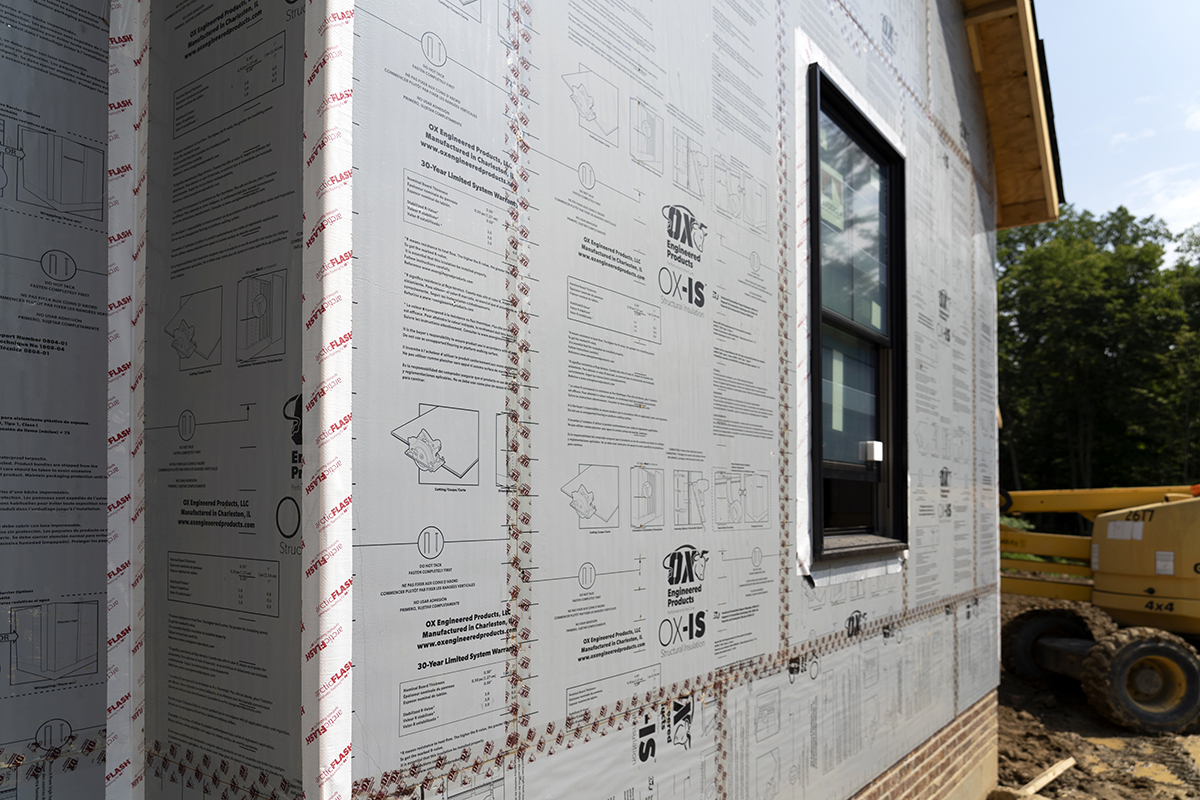CONTACT OX
TO LEARN MORE
Give us a call at 800-345-8881 or fill out the form below
and we’ll get back to you within two business days.

Indecisive on insulation type? Here’s a one-to-one comparison.
Modern Insulation Methods
Think back to the first time in your life you saw insulation.
Was it fluffy, loose-fill in the attic trusses your childhood home?
Was it traditional batt insulation visible in the walls or ceilings of an unfinished basement?
When someone says “insulation,” most people think of big, thick batts that fill the void between studs in walls and floors. However, product innovations in insulation, such as rigid foam board, are encouraging builders everywhere to incorporate them into their projects.
That presents a new dilemma. Which rigid foam board insulation type is the best? Two popular options to choose from are polyiso and graphite polystyrene.
Graphite Polystyrene
Graphite expanded polystyrene (GEPS) insulation is a rigid foam board product that is used for both new construction and retrofit projects. In fact, according to BASF, GEPS can provide up to 20% more energy savings for homes and buildings compared to its traditional white expanded polystyrene counterpart. The addition of graphite to the product reduces radiant heat transfer, delivering more favorable thermal conductivity.
However, where builders and installers need to be cautious is during its installation.
GEPS is sensitive to solar radiation, meaning it heats up faster than other types of rigid foam board under direct sunlight. For installation in hot, sunny climates in the West and Southwest, this is an important consideration. If exposed for long periods of time, the product surface can heat to upwards of 175º F (80º C). At this temperature, the surface of GEPS products could potentially bend or rupture. Therefore, it is important to protect it from sunlight during installation, or choose a product that has a reflective or light-colored facer.
Polyiso Insulation
Polyiso insulation is waterproof, flame retardant, lightweight, and eco-friendly. The material provides long-term energy savings for homes and commercial buildings because of its ability to achieve higher R-values, which reduces the negative impact a building has on the environment by reducing its overall energy consumption for heating and cooling needs.
Combining polyiso insulation with other components such as structural sheathing and air- and water-resistive barriers can help builders save money when purchasing materials. This also translates to time savings for installers, and of course, long-term benefits for tenants and owners because of the performance boost imparted by integrated products.
From a temperature perspective as a one-to-one comparison to GEPS, polyiso insulation is a thermoplastic material is not susceptible to temperature distortion. This plays an important role for installation in hot regions as well as in the case of a fire, where the material will not melt and drip, avoiding additional damage.
Head-to-Head: Installation
GEPS products are not as thermally efficient as polyiso products. Therefore, these products must be made thicker to achieve the same R-value as polyiso insulation. For example, OX-IS structural insulated sheathing with an R-value of R-3 is ½-inch thick. By comparison, popular GEPS products come in at ¾-inch thick. While this minor difference may not seem like much, it has a significant impact on the design of a structure. This is because anything thicker than half an inch requires builders to change out the window jams to accommodate the additional thickness. If a thermal value of R-3 is appropriate for your project, choosing a thinner polyiso product will allow you to keep traditional window jams. It will also lead to a thinner (yet still high-performing) wall.
Otherwise, installation methods and processes remain relatively the same for GEPS and polyiso. Both products are lightweight and efficient from an installation perspective. In addition, they both allow crews to install just one product (instead of three) by combining the structural, insulating, and weather-resistive components into a singular solution.
Bottom Line
There is no doubt that insulation has come a long way. However, even with modern, high-performance insulation materials, construction stakeholders still have to weigh the pros and cons of whichever option they select.
Both graphite EPS and polyiso insulation materials have benefits, but polyiso materials hold up better against radiant heat. Polyiso can also be made thinner while offering the same R-values that it would take a thicker piece of GEPS to achieve.
Curious to learn more about the benefits of polyiso insulation and how it can even help builders earn 45L tax credits?
Discover the Strength of OX.
